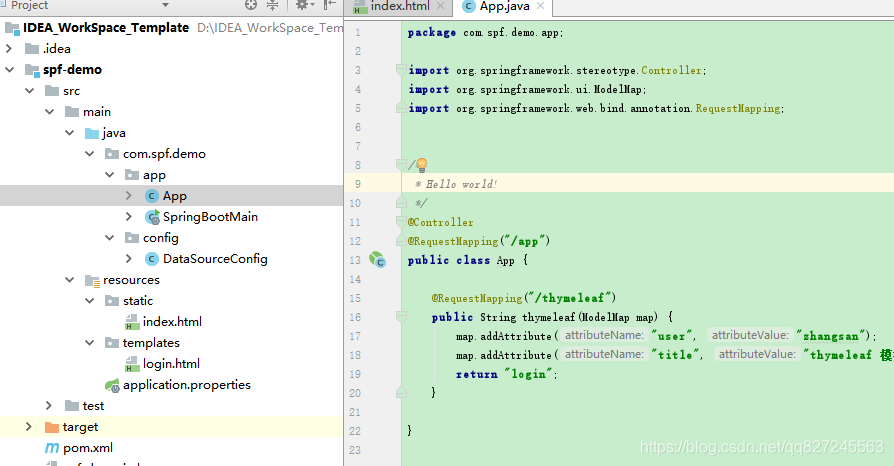SpringBoot教程(九)springboot整合Thymeleaf
阿新 • • 發佈:2018-12-26
一.Thymeleaf簡單整合
1.專案結構

2.pom依賴
<?xml version="1.0" encoding="UTF-8"?> <project xmlns="http://maven.apache.org/POM/4.0.0" xmlns:xsi="http://www.w3.org/2001/XMLSchema-instance" xsi:schemaLocation="http://maven.apache.org/POM/4.0.0 http://maven.apache.org/xsd/maven-4.0.0.xsd"> <modelVersion>4.0.0</modelVersion> <parent> <groupId>org.springframework.boot</groupId> <artifactId>spring-boot-starter-parent</artifactId> <version>2.1.1.RELEASE</version> <relativePath/> <!-- lookup parent from repository --> </parent> <groupId>com.spf.demo</groupId> <artifactId>spf-demo</artifactId> <version>1.0-SNAPSHOT</version> <packaging>jar</packaging> <properties> <project.build.sourceEncoding>UTF-8</project.build.sourceEncoding> <maven.compiler.source>1.8</maven.compiler.source> <maven.compiler.target>1.8</maven.compiler.target> </properties> <dependencies> <dependency> <groupId>org.springframework.boot</groupId> <artifactId>spring-boot-starter</artifactId> </dependency> <dependency> <groupId>org.springframework.boot</groupId> <artifactId>spring-boot-starter-web</artifactId> </dependency> <dependency> <groupId>org.springframework.boot</groupId> <artifactId>spring-boot-starter-jdbc</artifactId> </dependency> <dependency> <groupId>org.springframework.boot</groupId> <artifactId>spring-boot-starter-logging</artifactId> </dependency> <dependency> <groupId>org.springframework.boot</groupId> <artifactId>spring-boot-starter-test</artifactId> <scope>test</scope> </dependency> <dependency> <groupId>mysql</groupId> <artifactId>mysql-connector-java</artifactId> <version>5.1.45</version> </dependency> <dependency> <groupId>org.springframework.boot</groupId> <artifactId>spring-boot-starter-thymeleaf</artifactId> </dependency> </dependencies> <build> <pluginManagement><!-- lock down plugins versions to avoid using Maven defaults (may be moved to parent pom) --> <plugins> <plugin> <groupId>org.springframework.boot</groupId> <artifactId>spring-boot-maven-plugin</artifactId> </plugin> </plugins> </pluginManagement> </build> </project>
3.application配置檔案
###Tomcat Config server.port=8080 server.tomcat.uri-encoding=UTF-8 ####DataSource Config spring.datasource.platform=mysql spring.datasource.url=jdbc:mysql://127.0.0.1:3306/lpinfo?useSSL=false&useUnicode=true&characterEncoding=utf8 spring.datasource.driverClassName=com.mysql.jdbc.Driver spring.datasource.username=root spring.datasource.password=123456 ###SPBdefaultLoggin Config logging.level.root=info #設定檔案,如會在該專案下生成日誌檔案 logging.file=spf_demo.log #設定檔案會在某個資料夾下生成檔案寫入日誌 #logging.path=/usr/log/spf_demo.log ####thymeleaf Config # 模板格式 spring.thymeleaf.mode=HTML5 spring.thymeleaf.encoding=UTF-8 spring.thymeleaf.servlet.content-type=text/html spring.thymeleaf.cache=false
4.控制層
package com.spf.demo.app; import org.springframework.stereotype.Controller; import org.springframework.ui.ModelMap; import org.springframework.web.bind.annotation.RequestMapping; /** * Hello world! */ @Controller @RequestMapping("/app") public class App { @RequestMapping("/thymeleaf") public String thymeleaf(ModelMap map) { map.addAttribute("user", "zhangsan"); map.addAttribute("title", "thymeleaf 模板測試"); return "login"; } }
5.index頁 放在static檔案下 預設訪問到

6.index請求控制層-->跳轉登入頁面

7.執行結果

二.Thymeleaf語法語法講解
1.語法圖解

表示式語言
Thymeleaf模板引擎在進行模板渲染時,還會附帶一個Context存放進行模板渲染的變數,在模板中定義的表示式本質上就是從Context中獲取對應的變數的值:
<p>Today is: <span th:text="${today}">13 february 2011</span>.</p>URL
URL在Web應用模板中佔據著十分重要的地位,需要特別注意的是Thymeleaf對於URL的處理是通過語法@{...}來處理的。Thymeleaf支援絕對路徑URL:
<a th:href="@{http://www.thymeleaf.org}">Thymeleaf</a>另外,如果需要Thymeleaf對URL進行渲染,那麼務必使用th:href,th:src等屬性,下面是一個例子
<a href="details.html" th:href="@{http://localhost:8080/gtvg/order/details(orderId=${o.id})}">view</a>
<!-- Will produce '/gtvg/order/details?orderId=3' (plus rewriting) -->
<a href="details.html" th:href="@{/order/details(orderId=${o.id})}">view</a>
<!-- Will produce '/gtvg/order/3/details' (plus rewriting) -->
<a href="details.html" th:href="@{/order/{orderId}/details(orderId=${o.id})}">view</a>運算子
在表示式中可以使用各類算術運算子,例如+, -, *, /, %
th:with="isEven=(${prodStat.count} % 2 == 0)"迴圈
渲染列表資料是一種非常常見的場景,例如現在有n條記錄需要渲染成一個表格<table>,該資料集合必須是可以遍歷的,使用th:each標籤:
<table>
<tr>
<th>NAME</th>
<th>PRICE</th>
<th>IN STOCK</th>
</tr>
<tr th:each="prod : ${prods}">
<td th:text="${prod.name}">Onions</td>
<td th:text="${prod.price}">2.41</td>
<td th:text="${prod.inStock}? #{true} : #{false}">yes</td>
</tr>
</table>
條件求值
If/Unless
Thymeleaf中使用th:if和th:unless屬性進行條件判斷,下面的例子中,<a>標籤只有在th:if中條件成立時才顯示:
<a th:href="@{/login}" th:unless=${session.user != null}>Login</a>Switch
Thymeleaf同樣支援多路選擇Switch結構:
<div th:switch="${user.role}">
<p th:case="'admin'">User is an administrator</p>
<p th:case="#{roles.manager}">User is a manager</p>
</div>Utilities
為了模板更加易用,Thymeleaf還提供了一系列Utility物件(內置於Context中),可以通過#直接訪問:
#dates#calendars#numbers#stringsarrayslistssetsmaps- ...
下面用一段程式碼來舉例一些常用的方法:
